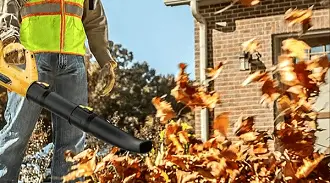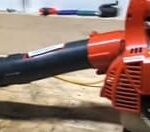As an Amazon Associate, this site earns commissions from qualifying purchases. For more information click here.
As leaves start to accumulate around your yard, it is time to get that trusty leaf blower OUT and take care of things. But what if the leaves are wet? Can your leaf blower still be effective? There are a lot of conflicting answers to this question, and in this post we will settle the issue once and for all.
A powerful leaf blower can handle wet leaves. But if the leaves are drenched, it is best to let them dry a little. Allowing the leaves to dry reduces the weight and makes collecting easier.
What Leaf Blower is Needed for Wet Leaves?
Contrary to popular belief, a leaf blower is capable of blowing wet leaves. Yes it will take more effort because wet leaves weigh more, but it can be done.
In order to use a leaf blower properly, you have to keep the following things in mind. Namely, power, how wet the leaves are and efficiency.
Power requirements. The more powerful the leaf blower, the easier it will be to use a leaf blower. Gas powered models are the most efficient for handling lots of damp leaves.
CFM and MPH. Leaf blower power is measured in CFM (cubic feet per minute) and MPH (miles per hour). The higher the numbers for these two, the more powerful the blower.
MPH refers to the speed by which air comes out of the blower. In theory the higher speed leads to efficiency. But this only works when there is a high CFM too.
CFM indicates the volume of air that emerges from the leaf blower per minute. The greater the volume the more leaves get moved. Combined with a high MPH and your leaf blower can dispense of those leaves quickly. If you are looking for a solid model, we recommend the Husqvarna 150BT as it packs a lot of power.
Aside from CFM and MPH, there are other factors to consider.
Ease of use. Clearing wet leaves can be a chore, so an easy to use blower is a must.
Durability. You need a powerful and durable leaf blower for wet leaves. This is especially true if you are going to do this regularly.
Ergonomics. This is usually left out in things to consider but try using a leaf blower for several minutes and you will appreciate an ergonomic design.
To get the best results your leaf blower has to be in good condition. It must have sufficient power since leaves weigh more wet than dry. Leaf blowers are versatile enough to be used to dry cars but there has to be enough power.

Leaf Blower Types for Damp Leaves
There are many types of leaf blowers, but they can be divided into two general categories: gas and electric. Battery powered leaf blowers are often classified as a subcategory of electric blowers.
Bottom line: gas powered leaf blowers are the best for blowing large volumes of wet leaves. Electric and battery powered blowers are suitable for occasional blowing of damp leaves.
Gas powered leaf blowers are the most powerful and well suited for wet leaves. They require some maintenance but if you deal with large volumes of damp leaves, a gas powered model is worth the investment.
Gas leaf blowers also require refueling and engine maintenance. This sounds like a lot of work, but for heavy duty applications, this is the best leaf blower type available.
An electric leaf blower is less expensive than gas. As long as it is plugged into a working power outlet it will keep running. There is no need to add fuel which is nice. If you only need to blow wet leaves on occasion and in small amounts, the Worx WG520 blower will work.
The problem is that most electric leaf blowers do not have the power to handle large amounts of heavy leaves. Your movement is also limited by the cord length. Move too far and the cord might snap loose.
An electric leaf blower is fine for occasional blowing of wet leaves in a small area. But if you have to deal with copious amounts of damp or soaked leaves regularly, a gas powered model is better.
Battery powered leaf blowers are convenient and portable. You are not limited by any cord and there is no need for refueling.
However, these are not as powerful as gas leaf blowers. Once the battery runs low you have to recharge it. This can be a hindrance if you have a lot of leaves to remove.
Handheld vs. Walk Behind vs. Backpack
Once you have decided on the type – gas or electric – you have to choose the design. There are three basic options: walk behind, backpack and handheld.
Walk behind. Also known as push leaf blowers, these gas powered units are the most powerful you can buy today. With 1300 CFM and higher, it is the right tool for professionals who have to remove large volumes of leaves, wet or dry.
Handheld. These are portable leaf blowers and known for their low cost, efficiency and ease of use. But these are only designed for dry or lightly wet leaves. If you have a small yard and only remove a few wet leaves, a handheld leaf blower will do.
Backpack. A backpack leaf blower is the ideal compromise between the large walk behind model and lightweight handheld types. Backpack blowers are heavier than handheld but still manageable and provide more power.
Bottom line: if you have a large yard, a walk behind leaf blower is the best option. For a medium size yard, a backpack blower is ideal. For a small garden and occasional removal of a few wet leaves, a handheld is fine.
How to Use a Leaf Blower on Wet Leaves
Leaf blowers have no trouble with lightly wet or damp leaves. But a pile of drenched leaves will be hard to work with.
Water can add a lot of weight to leaves. Drenched sufficiently, leaves might be stuck on the ground and be very difficult to remove.
How you use a leaf blower depends on how wet the leaves are.
If the leaves are soaking wet, let them dry. Even a powerful leaf blower will struggle and there is no need to overwork the engine. Once the leaves have dried a little, you can use the blower.
If the leaves are only lightly wet, you can use a blower right away. With a good CFM and MPH the blower should have no trouble picking up the leaves.
There might be instances where some of the leaves refuse to come off the ground. The best option is to use a rake or another tool to loosen them up. Then you can use the blower to take care of the rest.
You are probably wondering which is more effective, a leaf blower or rake. Some prefer one over the other, but a leaf blower wins out if it has enough power.
But as shown here there is no need to pick one. Use the rake to remove stubborn, stuck leaves and let the blower do the rest.
Troubleshooting Leaf Blowers
My leaf blower used to be able to pick up wet leaves but not anymore. Why?
Check the blower if there is blockage of some sort. It is also possible there is not enough fuel in the tank. If you replaced the fuel and the blower still won’t work, there could be a problem with the engine.
What CFM is required to blow wet leaves?
The higher the CFM and MPH the better. It is difficult to give an exact number because it depends on how much wet leaves you are blowing and how wet they are. In general, most backpack leaf blowers should be able to handle this job.
How wet can leaves be for leaf blowers?
It depends on how powerful your leaf blower is. Most blowers have no issues with wet leaves in small to medium volume. But when the leaves are completely drenched (after a heavy rainfall for instance), even a powerful blower will have a hard time. That is why you should let those drenched leaves dry.

I love the outdoors and all the tools for maintaining gardens, yards and lawns. The only thing I am more passionate about is sharing what I know about garden and outdoor equipment.


